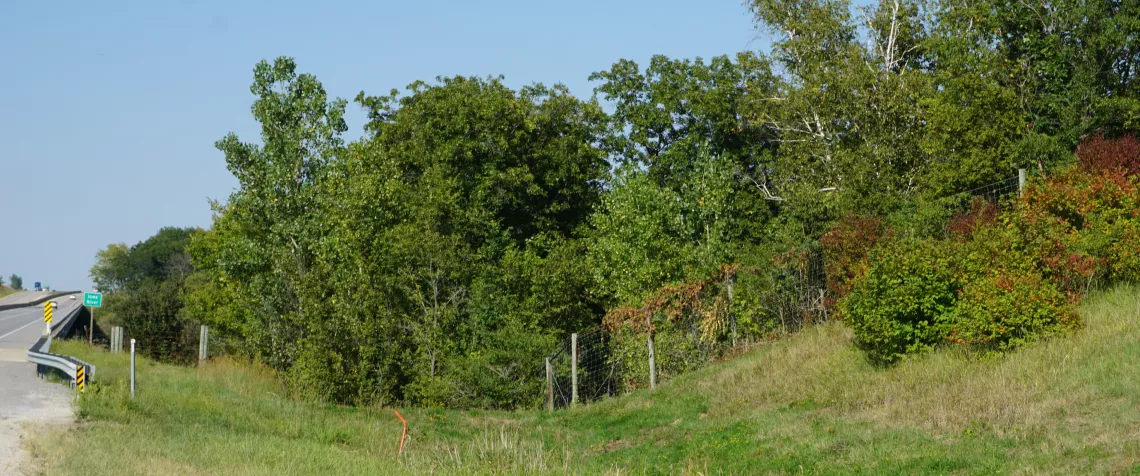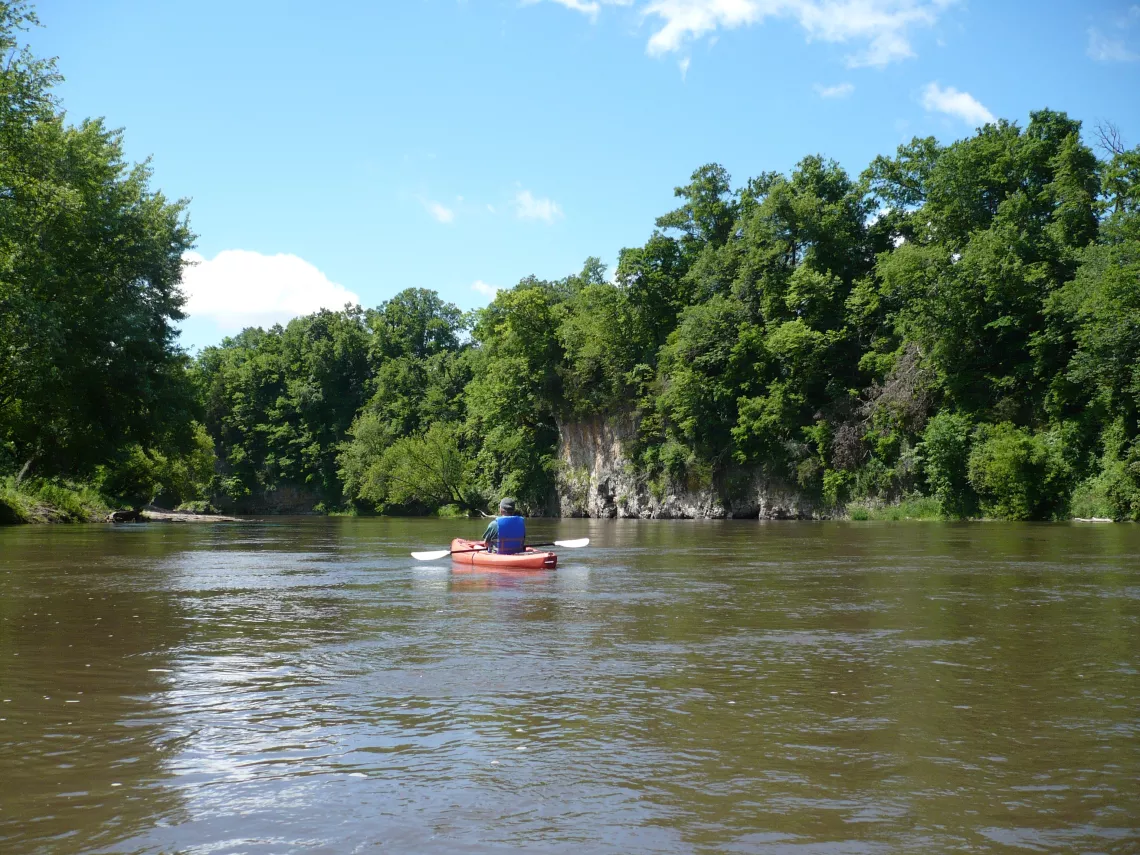Wildlife Corridors
Wildlife corridors are connections for plants and animals to move to survive in the future, connecting habitat areas that traverse across the landscape, allowing plants and animals to disperse in a semi-natural fashion, moving north due to climate change so they can find thermal happy zone, reconnecting fragmentation across the landscape,
Wildlife corridors connect key habitat areas. Small isolated populations tend to go extinct since there is no genetic exchange during breeding seasons. Wildlife corridors provide a better chance of keeping species alive.
The Iowa Department of Natural Resources created a Wildlife Action Plan. The Wildlife Action Plan is a good starting point and we need to continue implementation of the Plan. The Wildlife Action Plan for Cores and Corridors is a map of areas in the state that are prime for re-wilding.
As we implement policies to re-wild Iowa, private land will be part of the solution as well as public land. Private landowners can voluntarily protect their land as well as set conservation easements on the property that can keep the wild areas wild in perpetuity.
By protecting core areas and by providing buffers and then by connecting them with corridors, plants and animals will have a chance to re-wild Iowa.
Re-Wilding Iowa and Beyond - Restore, Reconnect, Re-Wild
Significant portions of Iowa are planted in corn and soybeans. Yet, there are areas in Iowa that remain wild. By continuing to work in protecting wild and natural areas, wildlife and native plants can thrive. Damaged areas can be re-wilded. And we can all benefit from greater access to wildlife, wildlands, and wild rivers.
Although Iowa does not have oceans and mountains, Iowa does have tall grass prairies, woods, savannas, prairie pothole wetlands, lakes and streams. Iowa enjoys incredibly diverse species of birds, mammals, fish, reptiles and amphibians. Even more significant is Iowa’s location – Iowa attracts some of the western-most species, some of the eastern-most species, and some of the northern-most species found in the country.
Yet many of the plants and animals found in Iowa are struggling to maintain sustainable populations. One of the big concerns is to create corridors so that wildlife can move safely from one location to another. Plants also need sufficient areas to keep their populations healthy.
Many of the natural areas that remain in Iowa are along rivers. Stream buffers and riparian woodlands provide a corridor. Wildlife and plants are able to populate stream buffers. Clean, unpolluted water, is also a corridor.
Bobcats have benefited from re-wilded areas, and have significantly expanded their range in Iowa. Black bear, cougars, and wolves have made periodic visits to the state, in an attempt to re-wild Iowa. Efforts are underway to restore milkweed, a plant required for monarch butterflies. Iowans have undertaken projects to restore prairie and to protect the prairie that remains.

Photo shows tall fencing intended to keep wildlife off Highway 20, near the Iowa River crossing in Hardin County, Iowa.
Citizen Science: collecting data on animal crossings
Iowa Wildlife Crossings & Roadkill
We are inviting Iowans to add observations of roadkill or successful animal crossings across Iowa roads. This will help us in demonstrating the need for wildlife corridors and safe sites for animal crossings (underpasses and overpasses) Iowa.
What participants do
Record the location of roadkills or unexpected live animal crossings in Iowa as animals move from one area to another. The link to the project is https://anecdata.org/projects/view/1254. To use it you need to set up an account on Anecdata, but it’s free. Anecdata was created by the Mount Desert Island Biological Laboratory to allow scientists and organizations to create Citizen Science Projects.
The REAP Preamble
Since the Europeans settled in Iowa, a significant amount of the state’s natural area has vanished. The Resource Enhancement and Protection (REAP) law,[1] adopted in 1989, summarizes the loss:
“The general assembly finds that:
1. The citizens of Iowa have built and sustained their society on Iowa’s air, soils, waters, and rich diversity of life. The well-being and future of Iowa depend on these natural resources.
2. Many human activities have endangered Iowa’s natural resources. The state of Iowa has lost ninety-nine and nine-tenths percent of its prairies, ninety-eight percent of its wetlands, eighty percent of its woodlands, fifty percent of its topsoils, and more than one hundred species of wildlife since settlement in the early 1800’s. There has been a significant deterioration in the quality of Iowa’s surface waters and groundwaters.
3. The long-term effects of Iowa’s natural resource losses are not completely known or understood, but detrimental effects are already apparent. Prevention of further loss is therefore imperative.
4. The air, waters, soils, and biota of Iowa are interdependent and form a complex ecosystem. Iowans have the right to inherit this ecosystem in a sustainable condition, without severe or irreparable damage caused by human activities.”
[1] Iowa Code, Section 455A.15 Legislative findings

Resources for more information
John W. Shaw, Inya Nlenanya, Mallary Allen, "Unreported Deer Crashes on Highways, final report", Institute for Transportation, Iowa State University, funded by Iowa Department of Transportation, December, 2023
Deer collision statistics from State Farm Mutual Automobile Insurance Company - Iowa ranks 7th in the likelihood of driver-animal collisions
Wikipedia discussion on Wildlife Corridors
Coloring sheet on wildlife corridors
Ben Goldfarb, "Ending Roadkill: How to Make It Safer for the Deer to Cross the Road", Sierra, March 26, 2024
"Wildlife Crossings Can Mend a Landscape", by Anne Pinto-Rodrigues, Sierra, February 21, 2024. Read about it
Cougar restoration in the Midwest, first article - "The Limitations of Puma Re-Colonization and the Strategy to Bring 'Em Back" by Christopher Spatz, August 23, 2023, Rewilding Earth
Cougar restoration in the Midwest, second article - "The Limitations of Puma Recolonization and the Strategy to Bring ‘Em Back: Part 2, Recovery" by Christopher Spatz, November 24, 2023, Rewilding Earth
See "We Need to Talk About Roadkill", by Jackie Flynn Mogensen, Mother Jones, September 14, 2023
See "Killer on the Road" by Ben Goldfarb in the fall, 2023, National Parks magazine
Ben Goldfarb, “Projects That Help Wildlife Navigate Highways Pick Up Speed”, Audubon, National Audubon Society, Fall, 2023
The US Department of Transportation initiated a pilot project for reducing wildlife vehicle collisions and supporting wildlife crossings, part of the 2021 Infrastructure and Jobs Act. Read about it
"Vermont Sets Ambitious Goal to Save Half of the State for Nature - New biodiversity measure aims to conserve 50 percent by 2050", by Lindsey Botts, Sierra, August 10, 2023. Read about it
"World's Largest Wildlife Crossing is Going Up So Animals Can Walk Safely Over 8 Lanes of L.A. Traffic", Good News Network, May 9, 2024
"How Climate Change is Leaving Some Species With 'Nowhere Left to Go'" by Fionna M. D. Samuels, Scientific American, July 5, 2022
Marina Bolotnikova, "It's Time to Stop Demonizing "Invasive" Species", Vox, November 28, 2021
Ryan Fonseca, "Roadkill data is shaping our understanding of California's wildlife", LA Times, October 12, 2023
Over & Under: Wildlife Crossings, Fourth Wall Films, directed and written by Kelly Rundle
A group of Iowans have been discussing what is needed to re-wild Iowa on a Facebook page. You are are invited to join the Facebook page, Re-Wilding Iowa and Beyond and join in the discussion about how Iowa can bring wildness back into the state.
"Assisted Migration Helps Animals Adapt to Climate Change - New federal regulations require rethinking our approach to conservation" by Joanna Thompson, October 12, 2023, Sierra
"In Montana, a Growing Population Spotlights the Need for Wildlife Corridors - Residents are finding creative, community-based solutions to mitigate harm" by Victoria Traxler, October 25, 2023, Sierra
Maryann Pugh, “Pennsylvania Takes Bold Steps to Protect Wildlife with New Report”, MyChesCo, Chester County, Pennsylvania, July 16, 2024
"A Study Pursuant to House Resolution 2023-87: The Current Status of Conservation Connectivity in Pennsylvania", Legislative Budget and Finance Committee, June, 2024